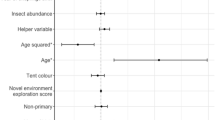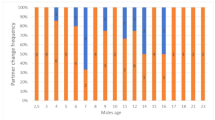Abstract
In monogamous birds, pair bond maintenance is often dependent on previous breeding success and each parent’s effort, because partners gain information about one another’s quality and contribution to brood rearing. The asymmetries between mates in parental investment have been theoretically linked to a sexual conflict of interests. Year-to-year pair fidelity decisions in relation to birds’ previous-year information about their mates, including territory quality and relative length of brood care, were explored in red‐necked grebes (Podiceps grisegena), a long-lived species with parent-fed young. Overall, mate retention was a major strategy (81.5% of pair-years). The probability of breakage/maintenance of a pair bond was not affected by previous-year hatching success, fledgling production, or territory quality in terms of food abundance for chicks. Reunited pairs bred earlier in the season than new pairs. In pairs that maintained bonds into the subsequent season, females typically terminated care 1–4 weeks before males. The male fidelity indicates that earlier brood abandonment by females may confer some fitness benefits to males and reflect coordination of reproductive effort at the behavioural level rather than exploitation of one partner by another.
Significance statement
Pair-living animals deciding whether to keep their old mate for future breeding usually consider their previous reproductive success and the partner’s effort. In some monogamous birds, often one of the parents leaves the brood before its mate, which is usually explained in terms of conflict between the sexes over parental care costs. I studied links between previous year’s parental effort and mate retention in red‐necked grebes, a long-lived waterbird. Grebes showed high pair fidelity irrespective of recent breeding success. In pairs that stayed together, females typically terminated brood care earlier than their mates. The male fidelity indicates that the unequal duration of brood attendance can be interpreted as cooperation and not conflict, especially as departing females did not attempt a second brood, while male-only care after female departure was sufficient to raise the young.
Similar content being viewed by others
Data availability
The datasets generated and/or analysed during the current study are available in the supplementary material.
References
Adkins-Regan, Tomaszycki M (2007) Monogamy on the fast track. Biol Lett 3:617–619
Akçay E, Roughgarden J (2009) The perfect family: decision making in biparental care. PLoS ONE 4:e7345
Angelier FH, Moe B, Clement-Chastel C, Bech C, Chastel O (2007) Corticosterone levels in relation to change of mate in black-legged kittiwakes. Condor 109:668–674
Beissinger SR (1987) Mate desertion and reproductive effort in the snail kite. Anim Behav 35:1504–1519
Bellebaum J, Szostek KL, Kloskowski J (2018) Population dynamics and survival of the Red-necked Grebe Podiceps grisegena: results from a long-term study in eastern Poland. J Ornithol 159:631–641
Black JM (2001) Fitness consequences of long-term pair bonds in barnacle geese: monogamy in the extreme. Behav Ecol 12:640–645
Bradley JS, Woller RD, Skira IJ, Serventy DL (1990) The influence of mate retention and divorce upon reproductive success in short-tailed shearwaters Puffinus tenuirostris. J Anim Ecol 59:487–496
Burke CM, Montevecchi WA, Regular PM (2015) Seasonal variation in parental care drives sex-specific foraging by a monomorphic seabird. PLoS ONE 10:e0141190
Choudhury S (1995) Divorce in birds: a review of the hypotheses. Anim Behav 50:413–429
Clutton-Brock TH (1991) The evolution of parental care. Princeton University Press, Princeton
Coulson JC, Thomas CS (1983) Mate choice in the kittiwake gull. In: Bateson P (ed) Mate choice. Cambridge University Press, Cambridge, pp 361–376
Culina A, Radersma R, Sheldon BC (2015) Trading up: the fitness consequences of divorce in monogamous birds. Biol Rev 90:1015–1034
Desrochers A, Magrath RD (1993) Environmental predictability and remating in European blackbirds. Behav Ecol 4:271–272
Dhondt AA, Adriaensen F (1994) Causes and effects of divorce in the blue tit Parus caeruleus. J Anim Ecol 63:979–987
Dreiss A, Roulin A (2014) Divorce in the barn owl: securing a compatible or better mate entails the cost of re-pairing with a less ornamented female mate. J Evol Biol 27:1114–1124
Dubois F, Cézilly F (2002) Breeding success and mate retention in birds: a meta-analysis. Behav Ecol Sociobiol 52:357–364
Eldegard K, Sonerud GA (2012) Sex roles during post-fledging care in birds: female Tengmalm’s owls contribute little to food provisioning. J Ornithol 153:385–398
Emlen ST, Oring LW (1977) Ecology sexual selection and the evolution of mating systems. Science 197:215–223
Ens BJ, Safriel UN, Harris MP (1993) Divorce in the long-lived and monogamous Oystercatcher Haematopus ostralegus: incompatibility or choosing the better option? Anim Behav 45:1199–1217
Gabriel PO, Black JM (2013) Correlates and consequences of the pair bond in Steller’s Jays. Ethology 119:178–187
Gratto-Trevor CL (1991) Parental care in semipalmated sandpipers Calidris pusilla: brood desertion by females. Ibis 133:394–399
Griffith SC (2019) Cooperation and coordination in socially monogamous birds: moving away from a focus on sexual conflict. Front Ecol Evol 7:455
Griffiths R, Double MC, Orr K, Dawson RJG (1998) A DNA test to sex most birds. Mol Ecol 7:1071–1075
Griggio M, Hoi H (2011) An experiment on the function of the long-term pair bond period in the socially monogamous bearded reedling. Anim Behav 82:1329–1335
Halimubieke NJ, Valdebenito O, Harding P et al (2019) Mate fidelity in a polygamous shorebird the snowy plover (Charadrius nivosus). Ecol Evol 9:10734–10745
Handel CM, Gill RE Jr (2000) Mate fidelity and breeding site tenacity in a monogamous sandpiper, the black turnstone. Anim Behav 60:471–481
Harris MP, Wanless S (2003) Postfledging occupancy of breeding sites by female common murres (Uria aalge). Auk 120:75–81
Kalmbach E, Griffiths R, Crane JE, Furness RW (2004) Effects of experimentally increased egg production on female body condition and laying dates in the great skua Stercorarius skua. J Avian Biol 35:501–514
Kelly EJ, Kennedy PL (1993) A dynamic state variable model of mate desertion in Cooper’s hawks. Ecology 74:351–366
Kloskowski J (1999) Prolonged incubation of unhatchable eggs in Red-necked Grebes (Podiceps grisegena). J Ornithol 140:101–104
Kloskowski J (2001) Double-brooding in Red-necked Grebes. Waterbirds 24:121–124
Kloskowski J (2003) Offspring desertion in Red-necked Grebes Podiceps grisegena. Ardea 91:25–34
Kloskowski J (2012) Fish stocking creates an ecological trap for an avian predator via effects on prey availability. Oikos 121:1567–1576
Kloskowski J (2021) Win-stay/lose-switch, prospecting-based settlement strategy may not be adaptive under rapid environmental change. Sci Rep 11:570
Kloskowski J, Grela P, Krogulec J, Gąska M, Tchórzewski M (2006) Sexing Red-necked Grebes Podiceps grisegena by molecular techniques and morphology. Acta Ornithol 41:176–180
Kloskowski J, Grela P, Gąska M (2012) The role of male nest building in post-mating sexual selection in the monogamous Red-necked Grebe. Behaviour 149:81–98
Kloskowski J, Kaczanowska E, Krogulec J, Grela P (2017) Hematological indicators of habitat quality: erythrocyte parameters reflect greater parental effort of Red-necked Grebes under ecological trap conditions. Condor 119:239–250
Kupán K, Székely T, Cruz-López M, Seymour K, Küpper C (2021) Offspring desertion with care? Chick mortality and plastic female desertion in Snowy Plovers. Behav Ecol 32:428–439
Ledwoń M, Neubauer G (2017) Offspring desertion and parental care in the Whiskered Tern Chlidonias hybrida. Ibis 159:860–872
Liker A, Freckleton RP, Székely T (2014) Divorce and infidelity are associated with skewed adult sex ratios in birds. Curr Biol 24:880–884
Lindén M (1991) Divorce in great tits – chance or choice? An experimental approach. Am Nat 138:1039–1048
Martell MS, Henny CJ, Nye PE, Solensky MJ (2001) Fall migration routes, timing, and wintering sites of North American ospreys as determined by satellite telemetry. Condor 103:715–724
McNamara JM, Barta Z, Fromhage L, Houston AI (2008) The coevolution of choosiness and cooperation. Nature 451:189–192
McNamara JM, Forslund P (1996) Divorce rates in birds: predictions from an optimization model. Am Nat 147:609–640
Moody AT, Wilhelm SI, Cameron-MacMillan ML, Walsh CJ, Storey AE (2005) Divorce in common murres (Uria aalge): relationship to parental quality. Behav Ecol Sociobiol 57:224–230
Morton ES, Stutchbury BJM, Chiver I (2010) Parental conflict and brood desertion by females in blue-headed vireos. Behav Ecol Sociobiol 64:947–954
Mumme RL (2018) The trade-off between molt and parental care in Hooded Warblers: simultaneous rectrix molt and uniparental desertion of late-season young. Auk 135:427–438
Nakamura M, Atsumi T (2000) Adaptive significance of winter pair bond in male pintail Anas acuta. J Ethol 18:127–131
Naves LC, Monnat JY, Cam E (2006) Breeding performance, mate fidelity, and nest site fidelity in a long-lived seabird: behaving against the current? Oikos 115:263–276
Olson VA, Liker A, Freckleton RP, Székely T (2008) Parental conflict in birds: comparative analyses of offspring development, ecology and mating opportunities. Proc R Soc Lond B 275:301–307
Orell M, Rytkonen S, Koivula K (1994) Causes of divorce in the monogamous willow tit, Parus montanus, and consequences for reproductive success. Anim Behav 48:1143–1154
Osorno JL, Székely T (2004) Sexual conflict and parental care in magnificent frigatebirds: full compensation by deserted females. Anim Behav 68:337–342
Paredes R, Insley SJ (2010) Sex-biased aggression and male-only care at sea in Brünnich’s Guillemots Uria lomvia and Razorbills Alca torda. Ibis 152:48–62
Pierce EP (1997) Sex roles in the monogamous Purple Sandpiper Calidris maritima in Svalbard. Ibis 139:159–169
Pierce EP, Oring LW, Røskaft E, Lifjeld JT (2010) Why don’t female purple sandpipers perform brood care? A removal experiment. Behav Ecol 21:275–283
Pitera AM, Branch CL, Sonnenberg BR, Benedict LM, Kozlovsky DY, Pravosudov VV (2021) Reproduction is affected by individual breeding experience but not pair longevity in a socially monogamous bird. Behav Ecol Sociobiol 75:101
Reed JM, Boulinier T, Danchin E, Oring LW (1999) Informed Dispersal Curr Ornithol 15:189–259
Rossmanith E, Blaum N, Höntsch K, Jeltsch F (2009) Sex-related parental care strategies in the lesser spotted woodpecker Picoides minor: of flexible mothers and dependable fathers. J Avian Biol 40:28–33
Sánchez-Macouzet O, Rodríguez C, Drummond H (2014) Better stay together: pair bond duration increases individual fitness independent of age-related variation. Proc R Soc B 281:20132843
Savard JPL (1985) Evidence of long-term pair bonds in Barrow’s Goldeneye (Bucephala islandica). Auk 102:389–391
Simmons KEL (1997) Brood-division, parental favoritism and parental desertion in the Great Crested Grebe. Bristol Ornithol 24:3–61
Spoon TR, Millam JR, Owings DH (2007) Behavioural compatibility, extrapair copulation and mate switching in a socially monogamous parrot. Anim Behav 73:815–824
Stout BE, Nuechterlein GL (1999) Red-necked Grebe (Podiceps grisegena). In: Poole A, Gill F (eds) The birds of North America, no. 465. The Birds of North America, Philadelphia
Svensson E, Nilsson JA (1997) The trade-off between moult and parental care: a sexual conflict in the blue tit? Behav Ecol 8:92–98
Székely T, Thomas GH, Cuthill IC (2006) Sexual conflict, ecology, and breeding systems in shorebirds. Bioscience 56:801–808
Trivers RL (1972) Parental investment and sexual selection. In: Campbell B (ed) Sexual selection and the Descent of Man, 1871–1971. Aldine, Chicago, pp 136–179
Vlug JJ (2007) Fortpflanzungsstrategien der Lappentaucher. Regulus 22:1–19
Westneat DF, Sargent RC (1996) Sex and parenting: the effects of sexual conflict and parentage on parental strategies. Trends Evol Ecol 11:87–91
Wojczulanis-Jakubas K, Jiménez-Muñoz M, Jakubas D et al (2020) Duration of female parental care and their survival in the little auk Alle alle - are these two traits linked? Behav Ecol Sociobiol 74:82
Acknowledgements
M. Gąska, K. Koperwas, J. Krogulec, M. Polak, P. Szewczyk, and numerous students helped in the field. M. Filipiuk and two anonymous reviewers provided valuable comments.
Funding
This work was supported by funding from the State Committee for Scientific Research (6 P04F00618 and 6 P04F06622 grants) and from the Polish Ministry of Science and Higher Education (2 P04G05030).
Author information
Authors and Affiliations
Corresponding author
Ethics declarations
Ethical standards
This study complied with the current laws of Poland. The ringing of birds was done under permits from the Ornithological Station of the Institute of Zoology, Polish Academy of Sciences. Blood sampling was approved by the Local Ethical Commission (Lublin) and the Polish Ministry of the Environment.
Conflict of interest
The author declares no competing interests.
Additional information
Communicated by C. R. Brown.
Publisher's Note
Springer Nature remains neutral with regard to jurisdictional claims in published maps and institutional affiliations.
Supplementary Information
Below is the link to the electronic supplementary material.
Rights and permissions
About this article
Cite this article
Kloskowski, J. High pair fidelity despite sex differences in the duration of parental care in a long-lived migratory bird. Behav Ecol Sociobiol 76, 45 (2022). https://doi.org/10.1007/s00265-022-03156-y
Received:
Revised:
Accepted:
Published:
DOI: https://doi.org/10.1007/s00265-022-03156-y




